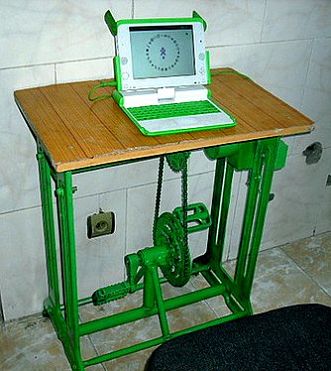Pedal While You Work, Exercise at Your Desk, Pedal Power
Now here's a fabulous idea.
Why not install cycle exercise machines under the office desks so that all the office workers can work-out at work - no need for time wasted at the gym!
Why not take it a step further and connect the exercise cycles to dynamos so that the exercise machines can generate power.
The workers can get paid for the power they generate and get fit at work!
Or they could use the power to run their laptops, cell-phones, iPhones, ipads, cameras or other devices.
Scientists in the US have conducted a feasibility study that suggests that portable pedal machines could be installed in every office to improve the health and well-being of workers
The research, published in the British Journal of Sports Medicine, claim that pedalling at work is the best way to beat sedentary lifestyles, which are a serious health problem and are a major cause of the obesity epidemic.
Under-Desk Pedal Machines

The researchers selected 18 full time employees and gave them a specially designed pedal exercise machine to use at their desks over a four week period. The pedal machine was designed so that they could use it while seated at their desks in the workplace. The mini exercise bike consisted of a set of pedals and compact fly-wheel, similar to that used for pedal radios. The unit could set up under the desk, in front of most standard office chairs. The units were not noisy and did not interfere with work. Several such devices are now commercially available.
The average age of the people used in the study was 40 years. Most of them were female who were overweight and had sedentary jobs involving spending at least 75% of every working day sitting at a desk or computer workstation.
The volunteers were connected to an exercise monitoring device installed on their computers, which tracked their activity and gave them real time feedback on pedaling speed, distance covered, and how many calories they burnt.
On average, the subjects used their pedal machines on 12 out of a possible 20 working days, with individuals ranging from 2 days use, up to the maximum of 20 days. The average time of use per day was 23 minutes and ranging from 1 to 73 minutes.
Whistle (Sorry!) - Pedal While you Work
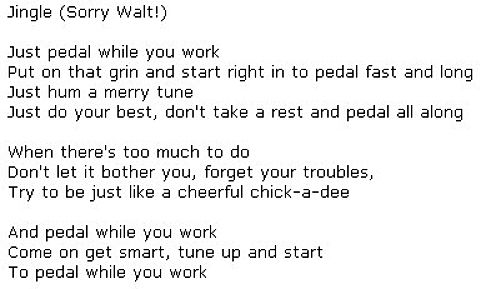

The total simulated distance travelled per day ranged from half a kilometre (a third of a mile) to almost 22 km (13.5 miles), with up to about 500 calories burned in the process.
At the end of the four week period, all the subjects provided feed-back and comments on how feasible it would be to introduce the machine into the workplace.
The volunteers found the machine was very easy to use and was a good alternative for exercise during bad weather.
Most said they would use the device regularly at work if it was offered by their employers and they said that using it had not affected either the quality of their work or their productivity.
The study showed that the novelty of the device appeared to wear off over time. However participants did maintain the level and intensity of activity over the four weeks, and just 23 minutes of pedaling could be beneficial to their health if done regularly.
The machines are available commercially and are relatively inexpensive. The concept would appear to offer potential for use in major workplaces as part of health programs for staff.
Why not take it a Step Further
- Competitions or 'Races' among your fellow workers?
- Achievement Goals and Records Published on Bulletin Boards?
- Pay the Workers for the Power they Produce
- Replace mains connected Computers with Pedal Powered Ones
The Pedal Radio
One of the earliest uses of pedal power was the pedal radio that was used during World War II and throughout the Australian Outback from 1930 to 1950.
The generator was quite similar to the modern under-the-desk exercise bike devices.
Pedal Power - using a Dynamo
Pedal Power is a well-known, but seldom used technique that allows bike riders to recharge their mobile phones, iPhones, GPS and other small devices in a safe and regulated way from a bicycle hub hargers or a bicycle dynamo fitted to their bikes.
In the 'good old’ days, a dynamo on a bike was only used for bicycle lights, which was the only electronic device on the bike or rider.
Bicycle lights have now been replaced with battery devices, but why not recharge while you ride. Modern riders use mobile phones, iPads, iPhones, GPS and other electronic devices that need recharging.
You can now power-up a wide range of appliances like iPhones, AA and AAA battery charges, GPS, mobile phones, digital cameras, MP3, iPod and iPads using modified dynamos. Specially designed devices can now be used for recharging while on the go safely and easily.
You can recharge any small device requiring 5V and up to a maximum power requirement of 600mA directly from the dynamo.

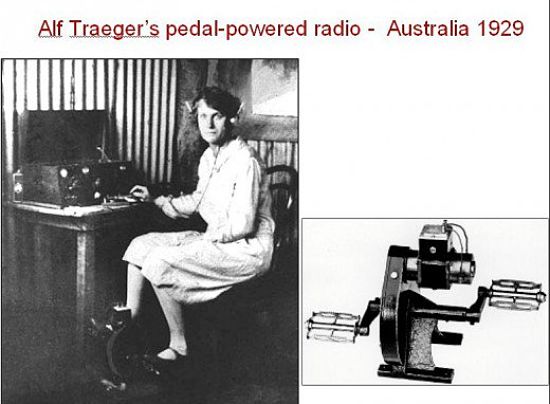
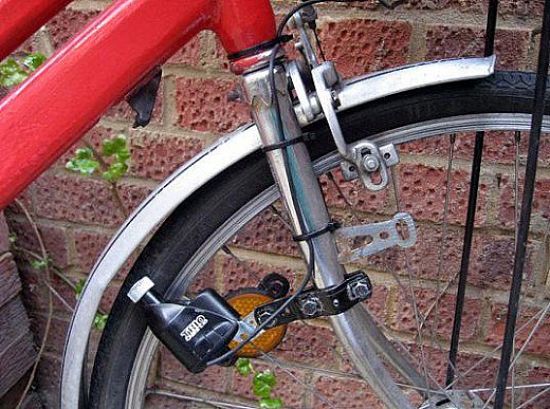
Peddle Power - Larger Applications
The iconic 'Peter Pedals' who founded the Pedal Power Juice Company and the Rainbow Power Company at Nimbin, on the North Coast of New South Wales, Australia, believes that Pedal Power can be taken a lot further.
Thirty years ago, he was regarded as a greenie, but now many of his ideas for solar and wind power have become mainstream.
Pedals says that once you embrace the ideal of clean energy, pedal-powered generators start to make a lot of sense.
In the past he has used an exercise bike to drive a generator for his spin-dryer and other appliances. The Rainbow Power Company, which he started in 1987, began as a stall at Channon markets selling solar batteries and switches. The company now employs more than 19 people and supplies solar technology throughout Australia and as far away as Somalia. The company was one of the pioneer alternative energy companies in Australia.
He began using bikes for power 30 years ago, initially building pedal machines that would directly drive appliances mechanically through appropriate gears and shafts rather than generating electricity. There is good reason for this.
Every energy conversion wastes energy in the conversion process. To generate electricity and then use it do do some work or activity wastes and lot of energy. Maybe the teams of Office workers should be connected up to mechanically drive the fans in the office or the air conditioning system.
For more than 30 years his Pedal Power Juice Company has been running stalls at markets through the Byron Bay area that uses a bicycle driven sugar cane crusher to extract fresh juice for the customers. He has also starred on the television shows That’s Incredible and Ripley’s Believe it or Not for his multi-speed pedal juicer machine (you can see one of his designs in operation at the pedal-power juice stall at The Channon market, that is held every month in the hinterland incland from Byron Bay).
Peter Pedals innovations don’t just stop at pedal-powered juicers. His has designed many energy-efficient environmental machines and devices including battery chargers, pedal-powered spin dryers and electric bikes. Peter has re-engineered many bicycles in his time and has electrified his own bike to help him to commute 12 km up-hill to work each day.
Bicycles can also be used to generate electricity and Peter has tried various designed. For stationary use he prefers to use the exercise bike for the obvious reasons that it comes with a stand.
To generate power you need to attach some kind of generator. He found that Car generators and alternators have many shortcomings.
The standard car alternator has the major disadvantage of being an all-or-nothing power generating device. Once you pedal it fast enough it tries to generate a huge amount of power and produces a high magnetic resistance that is very hard to pedal against.
Once the magnetic excitation is lost and you can start pedalling again until you build up enough speed and again experience the high resistance.
Recently he found a commercially available 250 watt permanent magnet motor, fitted with a bicycle sprocket and a built-in 10 to 1 gear box. This is ideal for a pedal generator. There are a number of commercial units available.
He has experimented with two versions of Pedal Power Systems
One was based on a very ordinary exercise bike. He found that the output from the standard exercise bike varied considerably, getting about 12 amps on the downstroke and about 8 amps when the pedals reach the top and bottom of the stroke.
The other is a Bionic Ergonometer that utilises both arm and leg movement and has a two-stage transmission. This makes the wheel turn at quite high speeds and the flywheel helps stabilise the output, which is very steady.
The exercise bike uses wind vanes to provide resistance when cycling. He found could manage a power output of 8 amps with the 6 wind vanes intact, but could get 8 to 10 amps with 3 wind vanes removed, and more than 10 amps when all the wind vanes were removed.
These measurements are with the pedal machine connected to a 12 volt battery and with 3 diodes in place.
Maintaining 10 amps for 1 minute is about the limit of his endurance, and 10 amps at 12 volts equates to 120 watts.
Pedal Power - Energy Output
Those 1500 watt appliances such as a spin dryer, would each need 10 fit people (this is taking into account some inverter losses) all pedalling as hard they can for the duration required for drying the clothes.
The fridge might run for say 10 out of 24 hours with the thermostat turning it off as soon as it gets cold enough. If it is a small fridge, this is the equivalent of 1 person pedalling like fury for 10 hours a day. This is somewhat impractical.
However, in an office this is exactly what you have - lots of people that could be connected up to power all sorts of office equipment including the office laptop computers.
(Sorry again Walt!)
Heigh ho, heigh ho
It's off to pedal we go
Heigh ho, heigh ho, heigh ho
We Pedal Pedal Pedal Pedal Pedal Pedal
In an office the whole day through
To Pedal Pedal Pedal Pedal Pedal Pedal Pedal
Is what we like to do
It ain't no trick to get rich quick
If you Pedal Pedal Pedal with a bike
In an office, in an office, in an office, in an office
Where a million diamonds shine
We Pedal Pedal Pedal Pedal Pedal Pedal Pedal
From early morn till night
We Pedal Pedal Pedal Pedal Pedal Pedal Pedal
Up everything in sight
We Pedal up miles by the score
A thousand miles sometimes more
But we don't know what we Pedal em for
We Pedal Pedal Pedal-a-Pedal Pedal
Pedal While You Work !
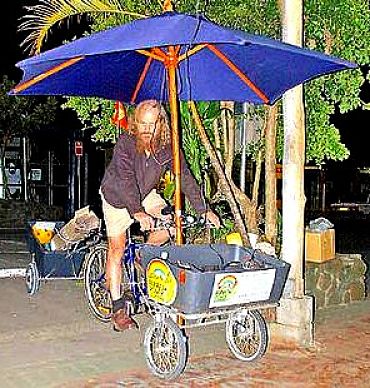


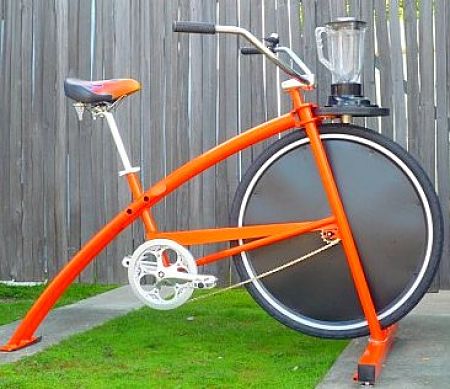
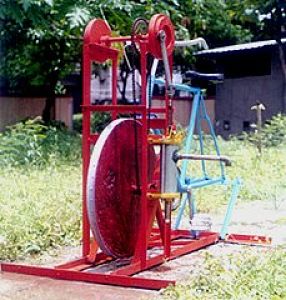
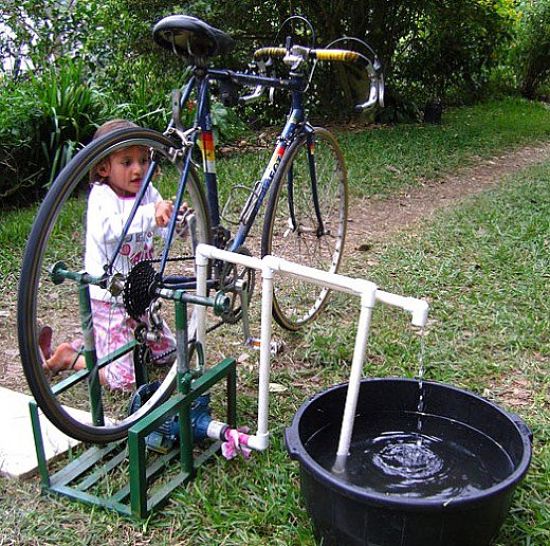
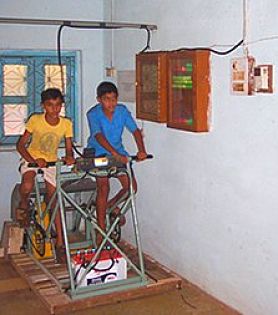
Related Articles
=> Stretching Exercises Before a Run or Workout May NOT Reduce Injuries
=> How to Increase Your Vertical Jump - Best Exercises, Training Tips
=> Exercise Prolongs Life - Which Type, How Much and Best Intensity?
=> How to Beat the Set Point Limit in Daily Exercise Routines
=> Q&A: Why Does Exercise Makes You Feel Good & Improve Your Physical and Mental Health
=> Tight Hamstrings - Causes, Treatment and Exercises to Stretch, Loosen
=> Short Intense Exercise Routines for Men, Women - Something Old is New Again
=> Isometrics Exercising Equipment with Pressure App, Hand Exercise Ball






